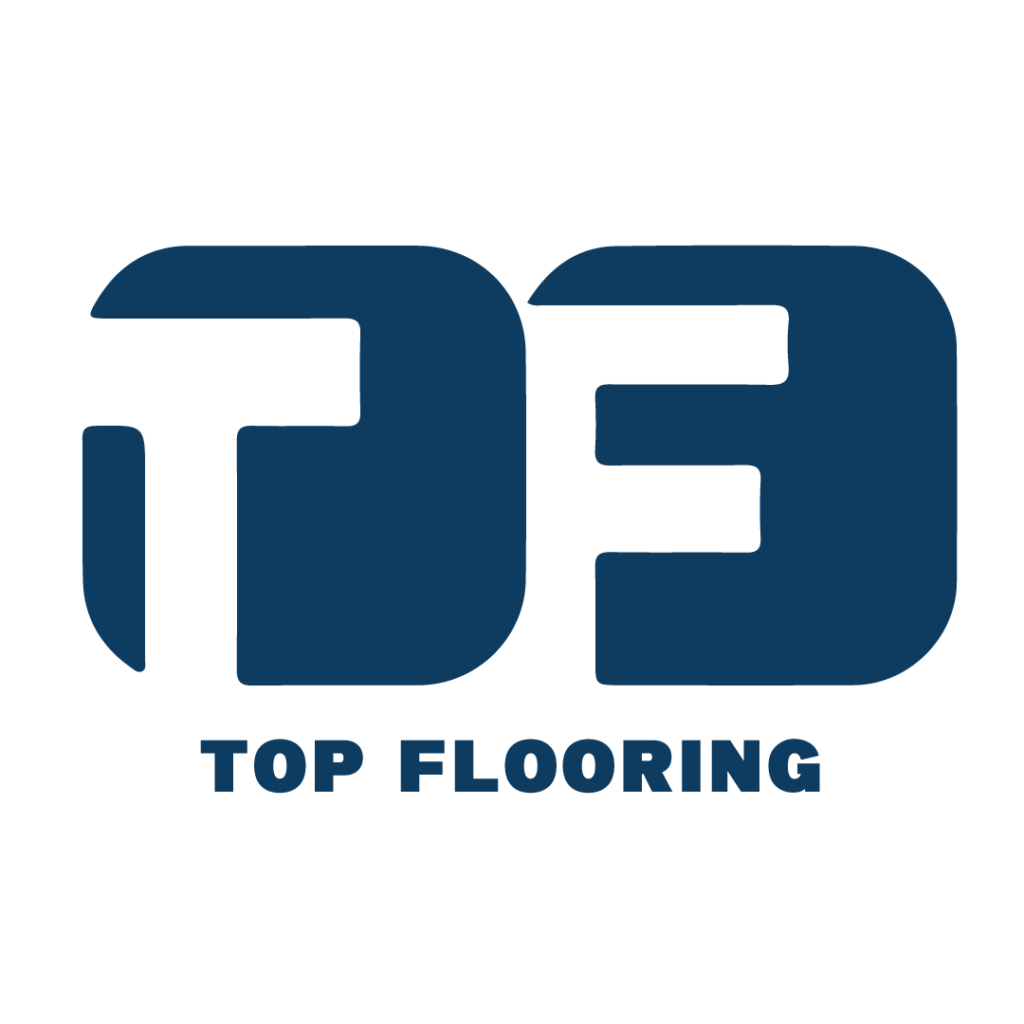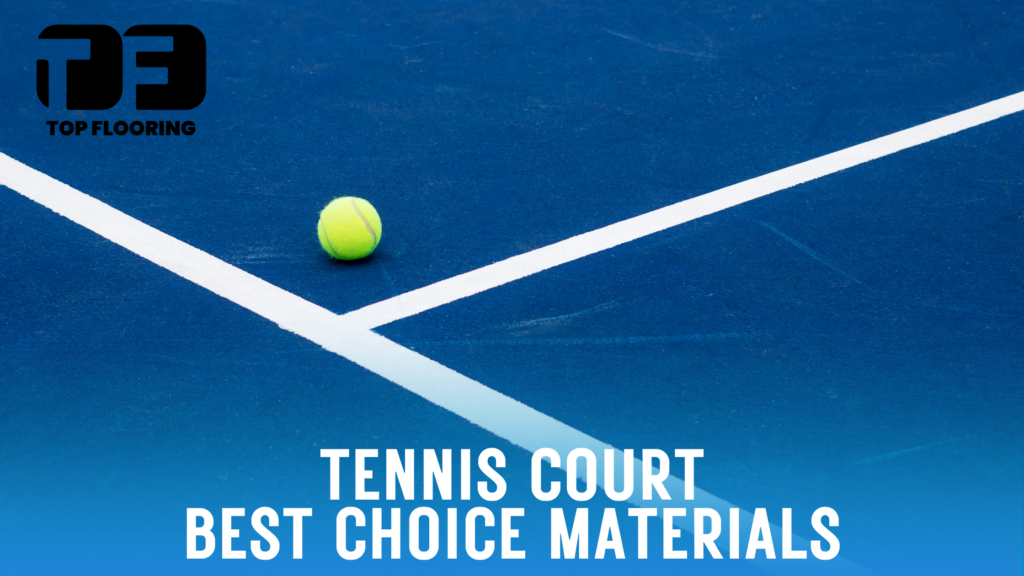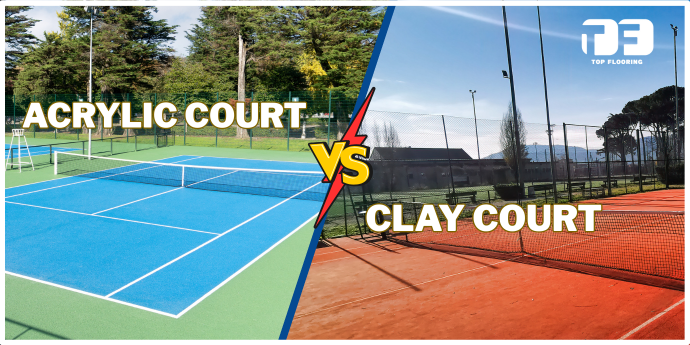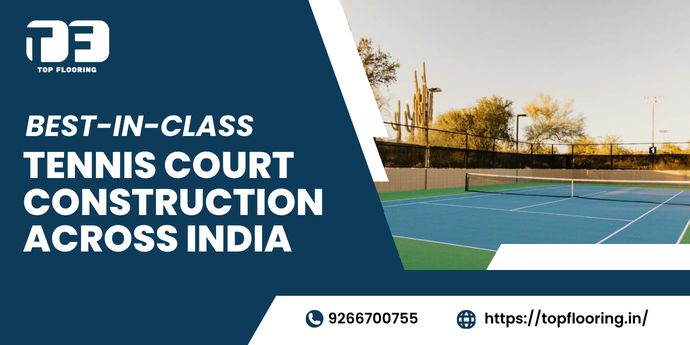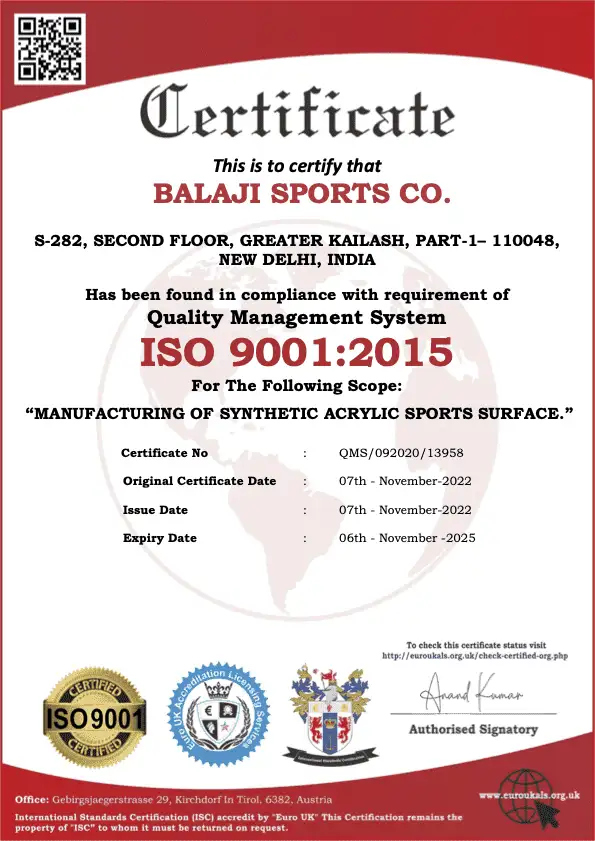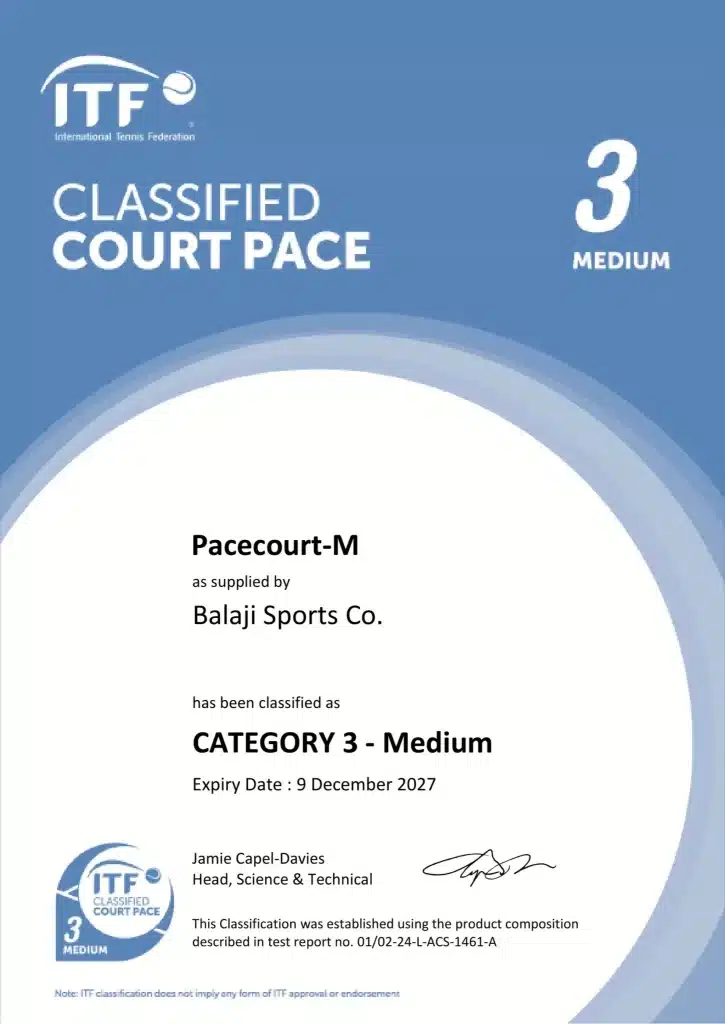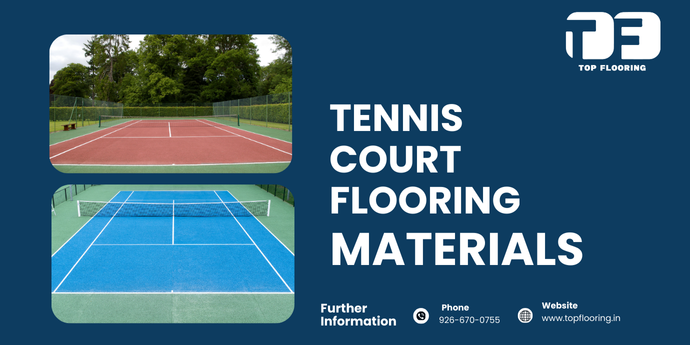
While designing a tennis court many sports facilities pay attention to details like dimensions, lighting, or fencing. However, the surface is where the real focus should be. The tennis court surface material you pick will affect durability, player performance, and the ongoing maintenance cost.
From the nostalgic clay courts to the quick bounce of grass and the ease of maintenance with acrylic, each tennis surface brings something unique. In India though, heat, rain, and constant wear put every option to the test. Some materials can’t handle it. Let’s dive into the top materials used for tennis courts today, their pros and cons, and why synthetic acrylic surfaces are turning into the favorite pick for places like schools, clubs, and sports centers.
How Tennis Court Material Change the Game
A tennis court is not just any kind of flooring. The surface changes how the game plays, keeps players safe, and even impacts the budget of a sports facility.
Clay courts make players rely on endurance and often lead to long rallies, but they need regular watering and rolling to stay in shape. Grass courts are known for their speed and classic feel, though they take a lot of effort to maintain. Acrylic tennis court surfaces however, stand out by combining durability with performance making them a top choice for both professionals and casual players.
This makes it clear that the choice of tennis court flooring material affects not how the game plays out but also how the facility operates.
Acrylic Tennis Court Material: The Modern Choice
If you visit most events, schoolgrounds, or local recreational centers today, you’ll see acrylic tennis courts. There is a strong reason behind this trend. These courts offer a balance between being practical to maintain and delivering solid performance.
Players like how the tennis court surface gives them a steady bounce and stops their feet from slipping. Facility managers choose it because it holds up well under India’s scorching sun and heavy monsoon rains. Acrylic courts, compared to clay or grass, do not need daily upkeep. A simple cleaning now and then use tennis court resurfacing materials every few years to keep the court in good condition.
Since synthetic acrylic tennis hard court surface material come in many colors. Tennis courts can be designed to reflect a brand, serve different sports, or even meet global standards. To find long-term value, facilities often pick acrylic as the go-to option.
Synthetic Grass: Where Tradition Meets Ease
Synthetic grass gives the appearance and feel of a grass court but eliminates the need to mow or water it. Players experience a faster game pace using this surface than they would on clay, and its soft texture feels kinder to the joints.
While it addresses many challenges of natural grass, it creates new ones. The fibers get flattened over time, so brushing becomes necessary, and the infill must be refilled . On courts with heavy use synthetic grass can wear out , which causes the ball to bounce .
Some clubs find it appealing, but in places with year-round busy courts, it might not be the best choice.
Clay Courts: Traditional, But High-Maintenance
Clay means long rallies, strategy, and endurance in the French Open. Coaches often suggest clay to train since it slows the ball down giving players time to improve stamina and footwork.
However, maintaining clay courts demands effort every day. Groundskeepers need to water, roll, and line courts often. Rain makes them unusable, and dry weather leads to dust issues. Facilities looking to save money or reduce hassle may find clay more trouble than it’s worth.
Wooden Courts: Uncommon but Classy
Wooden courts stay in indoor sports arenas where managing moisture and temperature is possible. They provide a sleek and polished playing surface with great ability to absorb impact. However, keeping them in good shape can be costly. Problems like water damage, scratches, and the need to refinish them often make them less practical for most places.
Wood might work well in upscale or niche indoor setups, but it is not a one-size-fits-all option.
Mixing Surfaces: Finding a Balance
Some places try out hybrid surfaces, like acrylic mixed with cushioning layers or synthetic grass backed by advanced support systems. These tennis court material types focus on balancing durability and comfort. They do their job well but are costly to set up and harder to look after when compared to regular acrylic surfaces.
Reasons Why Synthetic Acrylic Is the Top Choice for Tennis Courts
While every type of tennis court flooring brings something different, synthetic tennis court material stands out as the top choice of material for tennis courts across India.
Built to Last
Acrylic tennis courts handle years of games without showing wear and tear. Thanks to their ability to resist harsh conditions, they work well both indoors and outdoors.
Ready in Any Season
These courts perform well through blazing heat or heavy rain. Acrylic surfaces do not crack, fade, or bend ensuring matches go on no matter the time of year.
Easy to Maintain
Clay and grass courts demand constant upkeep, but acrylic requires occasional cleaning or a fresh coat. This reduces both effort and expenses for sports facilities.
Player-Friendly and Safe
Acrylic tennis court surfaces give players steady grip, slip protection, and cushioning options. This helps players avoid injuries.
Professional Standards
Major global tournaments like the US Open and Australian Open use acrylic-based courts. Facilities using synthetic acrylic surfaces stay in tune with international benchmarks.
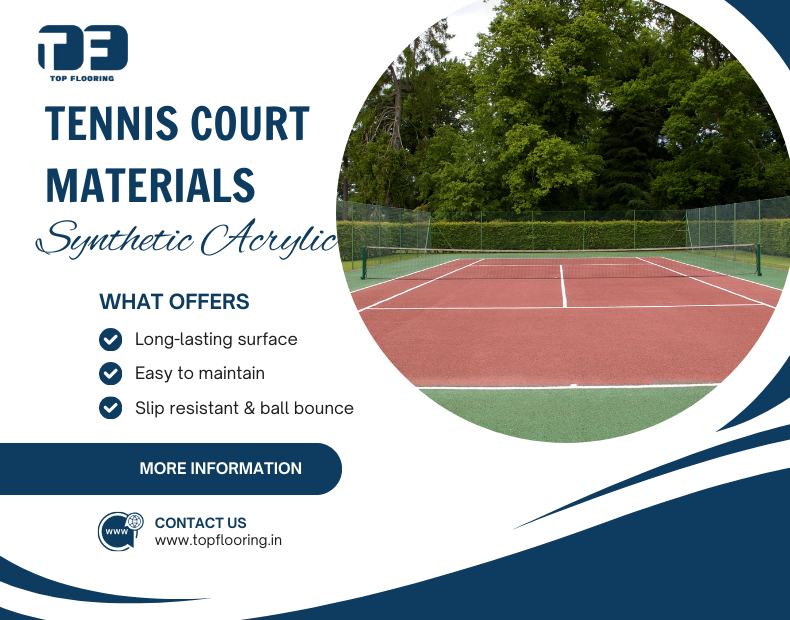
How to Pick the Best Outdoor Tennis Court Material for Your Facility
Budget Planning
You need to weigh upfront costs against future expenses. Acrylic lasts a long time and needs minimal upkeep making it the most budget-friendly option.
Facility Needs
- Training Facilities: Acrylic provides reliable surfaces for serious athletes.
- Schools and Universities: Its toughness and easy maintenance make acrylic a smart option.
- Clubs and Multi-Sport Centers: It’s easy to use acrylic courts for games like basketball and pickleball. They also work well for shared spaces.
Weather Suitability
India’s changing weather makes acrylic surfaces a better option than clay or grass. They stand strong through rain, heat, and moisture needing very little care.
Tips to Maintain Various Tennis Court Surfaces
To keep a tennis court ready for use, proper care matters as much as picking the right surface. Every type of tennis court material needs specific maintenance, and ignoring it can reduce the court’s durability.
Acrylic Courts
Acrylic courts are simple to look after. Sweeping them clears dust, leaves, and grit that could scratch the surface. Washing now and then with water and mild soap can clean up dirt and keep the court looking good and safe to play on. Courts need resurfacing every 5 to 7 years, depending on how much they are used, which is much less than what clay or grass courts need.
Synthetic Grass Courts
Artificial grass needs regular brushing to keep the fibers standing straight and to stop them from flattening out. Over time, you will need to refill infill materials like sand or rubber to keep the bounce even and players comfortable. Clearing away leaves and other debris is crucial to avoid clogging the drainage system.
Clay Courts
Clay courts take up a lot of care and effort. People need to water them every day to stop dust from forming and keep the surface solid. They also have to roll the courts often so the ground stays even. To make sure the lines don’t fade, players or staff must sweep them . Clay gives a special feel to games, but the high cost and time needed to maintain it make it tough for many places to handle.
Wooden Courts
Wooden courts need air conditions inside to keep the right humidity. If it gets too dry, wood can crack, but if it picks up too much moisture, it might bend. Polishing needs to happen to keep the surface safe, but letting water touch it can cause big problems. This setup makes wood less appealing for most facilities unless it’s a high-end indoor arena.
Future Trends in Tennis Court Floor Material
The world of sports surfaces keeps changing, and tennis courts are part of this shift. Today, facilities want more than just tough materials. They focus on sustainability, player comfort, and modern technology.
Tennis hard court material manufacturers now produce eco-friendly acrylic coatings with low VOC emissions to reduce harm to players, workers, and the environment. These coatings still provide reliable strength and performance. Facilities using these solutions also show support for global sustainability efforts.
Cushion-Coated Acrylic
Basic acrylic courts last long, but adding cushioning layers changes the game completely. These systems use several padding layers that help absorb shocks and ease the strain on joints like knees and ankles. Training academies and pro centers benefit the most since athletes practice for long hours every day. More people are adopting this trend as it boosts player safety while keeping performance unaffected.
Smart Court Technology
Tennis courts are stepping into the digital age. Some facilities are now blending sensors and performance-tracking systems into acrylic court surfaces. These smart courts keep track of player movements, measure how fast the ball travels, and even show analytics during training sessions. For clubs and sports centers, this setup adds a ton of value by using data to improve coaching and giving players a better, tech-savvy experience.
Conclusion
Sports facilities and academies need to pick the right tennis court ground material because it has an impact on safety, player experience, and long-term costs. Clay, grass, wood, and hybrid courts all have their pros, but none offer the same mix of performance, durability, and affordability that synthetic acrylic tennis court materials provide.
Top Flooring offers high-quality synthetic acrylic materials made to suit India’s climate and meet the needs of modern sports centers. Choosing the right tennis court surface now helps facilities achieve consistent performance, lower upkeep expenses, and maintain a professional-level playing experience for years ahead.
Frequently Asked Questions
The best all-weather tennis court material is synthetic acrylic, as it resists UV rays, heavy rain, and temperature changes while providing consistent bounce and low maintenance.
Acrylic surfaces typically last 5–7 years before resurfacing is needed and can last over 20 years with proper care, making them longer-lasting than clay or grass courts.
Acrylic tennis court material requires the least maintenance. Regular sweeping and occasional washing are enough, unlike clay or grass which need daily upkeep.
Choosing the right tennis court depends on budget, usage, and climate. For most sports facilities in India, synthetic acrylic material offers the best mix of performance, durability, and cost-efficiency.
Schools and academies prefer synthetic acrylic because it is durable, easy to clean, safe for beginners, and suitable for high daily usage.
Clay courts offer slower play and longer rallies but require heavy maintenance. Acrylic courts provide consistent bounce, all-weather durability, and lower upkeep, making them better for most facilities.
